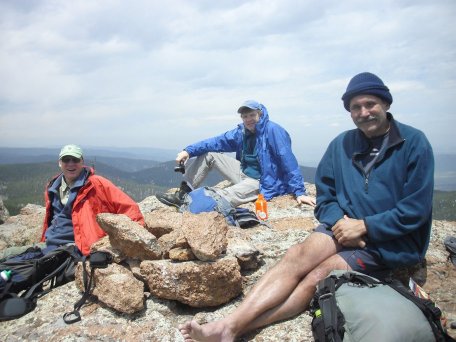Roger J. Wendell
Defending 3.8 Billion Years of Organic EvolutionSM


Me on top of Bergen Peak (2,960 metres) after a spring snowstormThis page is going to be a long work-in-progress as I didn't think of creating until I was 67-years-old in July, 2023. My guess is that I had hiked and climbed about 500 different peaks and summits before then! (not counting my 1,200 ascents of Mount Morrison by that age and dozens of other mountains that I repeated many times as well...)
I started creating climbing pages with the 14ers in my early 50s. I then started adding the 12ers, 13ers, and higppoints pages in my early 60s. Prior to that I had completed countless 5ers, 6ers, 7ers, etc. that I had summited throughout my life but never recorded.
I climbed all of those as a boy in California, while on military duty in Hawai'i, and as a young man, adult, and then elder in Colorado. I suspect I'll never come close to piecing it all together but will try and record those I can remember or reference from other sources as time permits...
NOTE: LIDAR (Light Detection and Ranging) was put into use many decades after I started hiking and climbing. LIDAR is a more accurate way of measuring the Earth's surface and, as such, has changed what was believed to be the elevation of many mountains and highpoints. As a result, the "prominence" (at least 300 feet above a connecting saddle) of many mountains has changed along with their elevations. A personal example, for me, is Republican Mountain - a previously "unranked" 12er near Silver Plume that I climbed in 2022 after learning that LIDAR had determined it now had 312 feet of prominence. Peak 8, near Breckenridge is another personal example of change brought on by LIDAR. When I originally climbed Peak 8 I believed it to be a 12er, only to learn later that it's actual elevation is 13,005 feet! So, in summary, many of the elevations you see on my pages may not (yet) be accurate - requiring an update someday in the future as time permits!

|
Click Here for my 14ers page... |

|
Click Here for my 13ers page... |

|
Click Here for my 12ers page... |

|
Click Here for the Ten Essentials - Don't leave home without 'em! |

|
Click Here for my page on highpoints... |

|
Click Here for my general notes Climbing and Mountaineering. |

My List of Peaks Below 12,000 feet/3,657.6 metres:
7,886 feet, 813 feet of prominence - Colorado's 3,746th highest peak
11ers
10ers
9ers
8ers
7ers
6ers
5ers
4ers
3ers
2ers
1ers
0ers

Unranked (less than 300 foot rise)

Some Trailheads:

Prominence, a Definition:
In topography, "prominence" is the height of a mountain or hill's summit by the vertical distance between it and the lowest contour line encircling it and no higher summit - Prominence is a measure of the independence of a summit. Only summits with a sufficient degree of prominence are regarded as independent mountains. For example, the world's second-highest mountain is K2 (height 8,611 metres, prominence 4,017 metres). While Mount Everest's South Summit (height 8,749 metres, prominence about 10 metres) is taller than K2, it is not considered an independent mountain because it is a subsummit of the main summit (which has a height and prominence of 8,848 metres).

Yosemite Decimal System
The Yosemite Decimal System (YDS) is a three-part system used for rating the difficulty of hikes and climbs. YDS is primarily used by mountaineers in the United States and Canada. However, there are many different rating systems used around the world. Examples include the British trad grade, the French sport grade, and the International Climbing and Mountaineering Federation's (UIAA) alpine grade. As for the YDS, it was first devised by members of the Sierra Club in Southern California in the 1950s. YDS was a refinement of earlier systems, particularly those developed in Yosemite Valley.
Class 1: Hiking on a trail.
Class 2: Simple scrambling, with the possibility of occasional use of the hands. Little potential danger is encountered.
Class 3: Scrambling with increased exposure. Handholds are necessary. A rope could be carried. Falls could easily be fatal.
Class 4: Simple climbing, possibly with exposure. A rope is often used. Falls may well be fatal.
Class 5: Is considered technical roped free climbing; belaying is used for safety. Un-roped falls can result in severe injury or death. Class 5 has a range of sub-classes, ranging from 5.0 to 5.15d, to define progressively more difficult free moves.
| Classification of climbs can vary quite a bit depending on location and history. Indoor gym ratings tend to be inflated compared to outdoor ratings. Ratings tend to be lower in outdoor areas where climbing routes were developed in earlier years. Guidebooks have often raised the ratings on older climbs to make them more comparable to newer ratings. The YDS grade system also involves an optional Roman numeral grade that indicates the length and seriousness of the route. The grades are: |
|

 Tired hikers on Mount Fuji (12,388 ft) |
Links: |
|
|
| Warning! Climbing, mountaineering, and backcountry skiing are dangerous and can seriously injure or kill you. By further exploring this website you acknowledge that the information presented here may be out of date or incorrect, and you agree not to hold the author responsible for any damages, injuries, or death arising from any use of this resource. Please thoroughly investigate any mountain before attempting to climb it, and do not substitute this website for experience, training, and recognizing your limitations! |

 Back to Roger J. Wendell's Home Page...
Back to Roger J. Wendell's Home Page...
Abbey |
About |
Blog |
Contacting
Me |
Copyright |
Disclaimer |
Donate |
Guest
Book |
Home |
Links |
Site
Index |
Solutions |
Terms,
Conditions
and
Fair
Use |
What's
Changed
or
New?
Copyright
© 1955 -